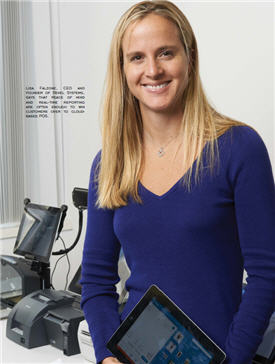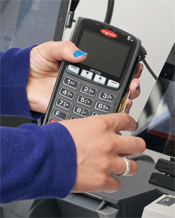iPad POS: Making Waves, Making Millions

By Matt Pillar, chief editor
Revel Systems is the undisputed leader in iPad-based POS. Here’s how the disruptive company has flourished where others have floundered.

n 2010, Revel Systems’ founder and CEO Lisa Falzone sold restaurateur Michael Lappert an iPad-based POS system that hadn’t even been created yet. Lappert was looking for an iPhone-based ordering app, which at the time was exactly what Revel sold. But when Falzone and CTO/co-founder Chris Ciabarra visited Lappert’s Fish and Chips store on a sales call, they uncovered a bigger opportunity — the POS. Lappert was not at all happy with his POS.
Though Falzone and Ciabarra had been thinking about an iPad-based POS application, they hadn’t actually built one yet. But as they discussed Lappert’s frustrations and challenges, it became clear that’s what he needed. They sold him POS software then and there, sight unseen, on the promise they could build it.
The risk paid off. This is the short story of how Revel Systems, still in start-up mode, profits from its pioneering iPad POS applications.
Demand, Then Go To Market
As Falzone and Ciabarra continued to push Revel’s mobile ordering application to restaurants, the Lappert’s Fish and Chips scenario inevitably repeated itself. “None of the restaurateurs we were pitching were happy with their existing POS systems,” says Falzone. “This was six months after the iPad was released, and it was clear the restaurant POS world was ready for disruption.” The company quickly pivoted from iPhone ordering apps to the bigger need — and bigger opportunity — the market presented.
“In retrospect, selling a product that hadn’t been created yet was nerve-wracking but smart,” says Falzone. “A lot of entrepreneurs spend 12 months building a perfectlyfunctioning, amazing product, and then learn the hard way that there’s no market demand. We wanted to make sure there was market demand, so we sold first and built later,” she says.

Building, as it turns out, was more difficult than Falzone anticipated. “When we started, it was all about funding engineering and research and development. Finding the right people to do that was our biggest challenge,” she says. “When we first started pitching for venture capital, most VC firms didn’t even know what POS was.”
As Falzone — who comes from a VC background herself — gained success exposing the iPad POS opportunity to investors and securing funding, Revel began to assemble a company. “It took us six months and a lot of luck to put our lead development team together,” she says. That development team put together a basic version of the software to start. As new feature requests came in from clients, the team built them into the product set in modular fashion. “While POS is the nucleus, what we’ve created is a mini, mobile ERP (enterprise resource planning),” says Falzone. Some of the more popular modules Revel sells include inventory control, analytics, and employee scheduling. Its open API (application programming interface) enables partner integration of gift card, loyalty, payment, and reservation applications.
Fast-forward to 2012. By then, POS — particularly mobile POS — was a hot topic in the investment community. Revel Systems was raking in millions in venture capital funding—and it was profitable. It grew so quickly that the company struggled to hire qualified people fast enough to answer its inbound sales volume. In January of that year, Revel received another shot in the arm when it won the “Best iPad Business App of the Year” award at the Macworld/iWorld event. In just two years, Revel Systems had gone from a company whose first sale was admittedly “vaporware,” to an award-winning ISV (independent software vendor).
Tablets Really Can Make Money
Falzone says every lead the company has funneled to its sales reps for the past three years has been inbound, and after a demo, those leads almost always close in a sale. She also says that as the company has grown, so has the size of its customers. While many VARs have struggled to make money on mobile POS — paying their traditional operating and sales overhead to pitch low-priced tablets to small shops — Revel has moved upstream and embraced a hybrid revenue model. “We’re focused on catering to higher-end chains, franchises, and large-volume single store locations, where we can sell a lot of devices at a higher margin,” says Falzone. “When we started the business, we were aware of two competitors in the iPad POS market. Now there are more than a hundred,” she says. Revel is one of — if not the — largest, and its solution set is considerably more full-featured than most of its competition. Falzone says that justifies the fact that her company’s offering is a bit more expensive than most in the tablet POS market.

Falzone says Revel is in the early stages of offering its iPad POS solution via select resellers in the channel and that the profit opportunities are both up-front and recurring. Revel leverages leasing agencies to make larger rollouts attainable for its customers, and the company isn’t averse to backing clients through internal lease deals. Falzone says Revel uses plenty of discretion with customers that don’t qualify for external leasing options. “Often times we’ll work with them, but we ask for one-third up front for license fees and development work, which is especially important if we’re financing the project internally,” she says. “If the potential client has bad credit, however, we won’t take that risk.”
Recurring revenue is generated via a $100.00 per month SaaS (Software as a Service) charge per device, as well as through commission revenue from third-party payment processing, loyalty, and online ordering applications.
Overcoming The Classic Objections To iPad
While they’re clearly hungry for change, businesses in Revel’s target market — chain stores, franchises, the big national brands — often present a classic objection to an iPad-based POS. “These larger chains are used to working with 100-year-old legacy POS providers like NCR. They often question the iPad’s rigidity, whether it’s too fragile for the rigors of POS duty, particularly in hospitality,” says Falzone. She claims the iPad, which has no holes, vents, or mechanical fans, is more durable than traditional Windows devices. “In harsh hospitality environments, that’s important,” she says. High-volume restaurant environments typically have to replace their legacy POS touch screens every six months or so, but that’s not the case with iPads, she says. “We’ve never had to replace the glass touch screen on an iPad. It also requires a softer touch than legacy screens, which have to be pounded on to get a response.”
Falzone says her company occasionally faces an objection to its SaaS delivery model, which is overcome through demonstration of the software’s “complete offline mode.” In this mode, when the Internet is down, the entire system continues to operate offline in batch mode. When connectivity is restored, transactions are retrieved without manual intervention. “That peace of mind, combined with the advantages of SaaS — primarily real-time reporting — is often enough to win customers over to cloud-based POS,” says Falzone. “Most of these business owners are not happy with their legacy systems running in the back office, so it’s not a great struggle to move them past those unfounded objections.”
Where Does The POS Go From Here?
Falzone has a fresh perspective on POS hardware and software. She wasn’t selling it a mere ten years ago, when a box, a pole display, and a tangle of cords were standard fare at the cash wrap. That gives her a take on the future of the POS that’s unencumbered by a legacy mindset. “I think the POS will move ever closer to the end consumer, giving more control to customers via their mobile devices,” she says. That transfer of control, she advises, will force transition for the traditional POS reseller. “Ordering applications will be huge, and so will mobile wallets, which are a potential coups for retailers; the consumer’s wallet and the retailers’ shopping application will live on the very same device,” says Falzone.
She says the next-generation POS will play a central role in how mobile payments and mobile loyalty applications work, creating a huge channel opportunity for application integration at the POS. That next-gen POS is one that’s cloud-based, real-time, and cross-channel, she says. “It’s the convergence of Web 2.0 and brick-and-mortar retailing. We’ll see one integrated commerce system for all channels, the control of which will increasingly rest in the hands of the consumer,” concludes Falzone.
Revel Systems’ embrace of rapid change at the POS is paying off today — the startup was profitable within the first two years after the solution launched and continues to attract investors. While its entrepreneurial approach to POS in the new “age of the consumer” might breed more nerve-wracking moments for Falzone and Ciabarra, the company’s all-in approach to meeting market demand with modern technology serves well to remind old-guard VARs not just what they’re up against but why they got into this business in the first place.

